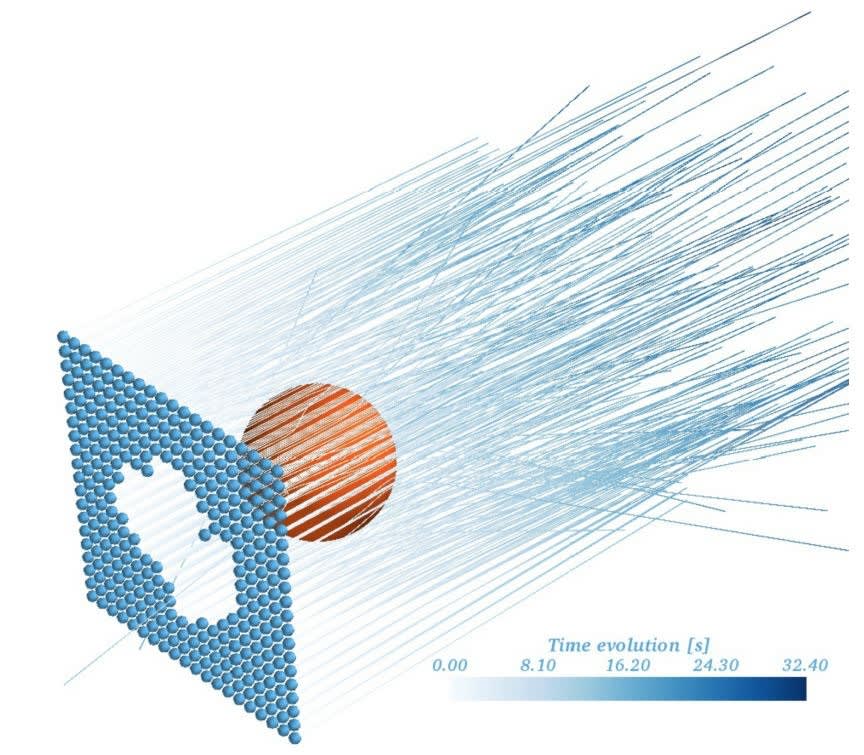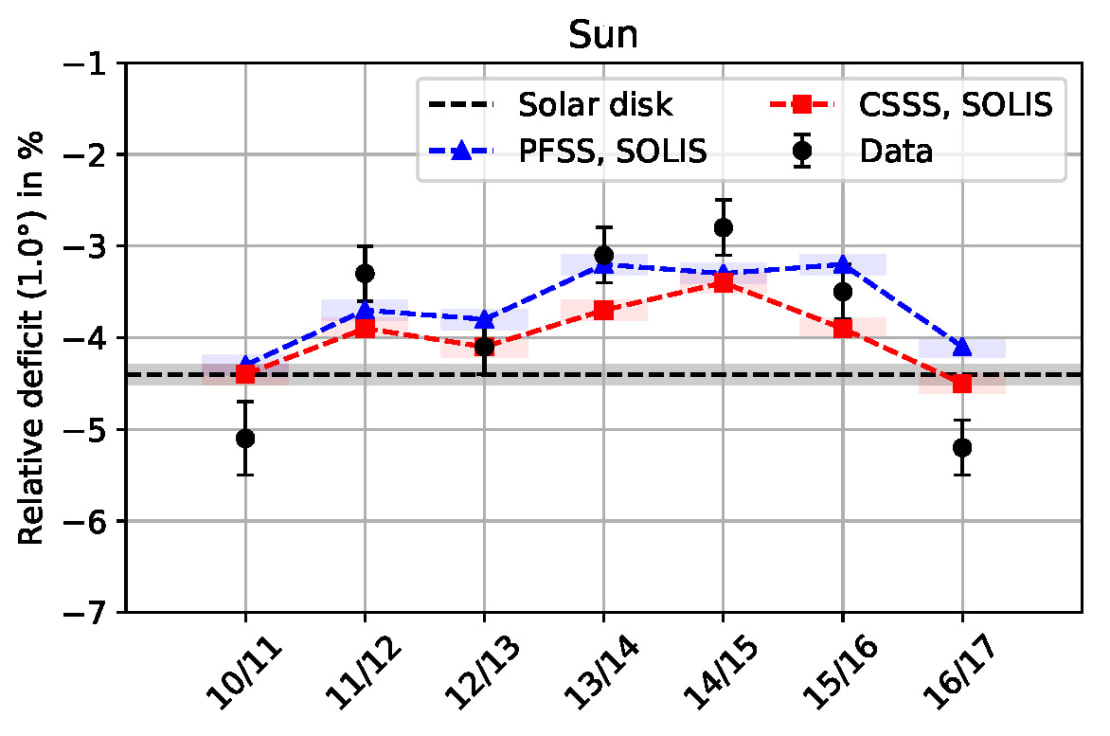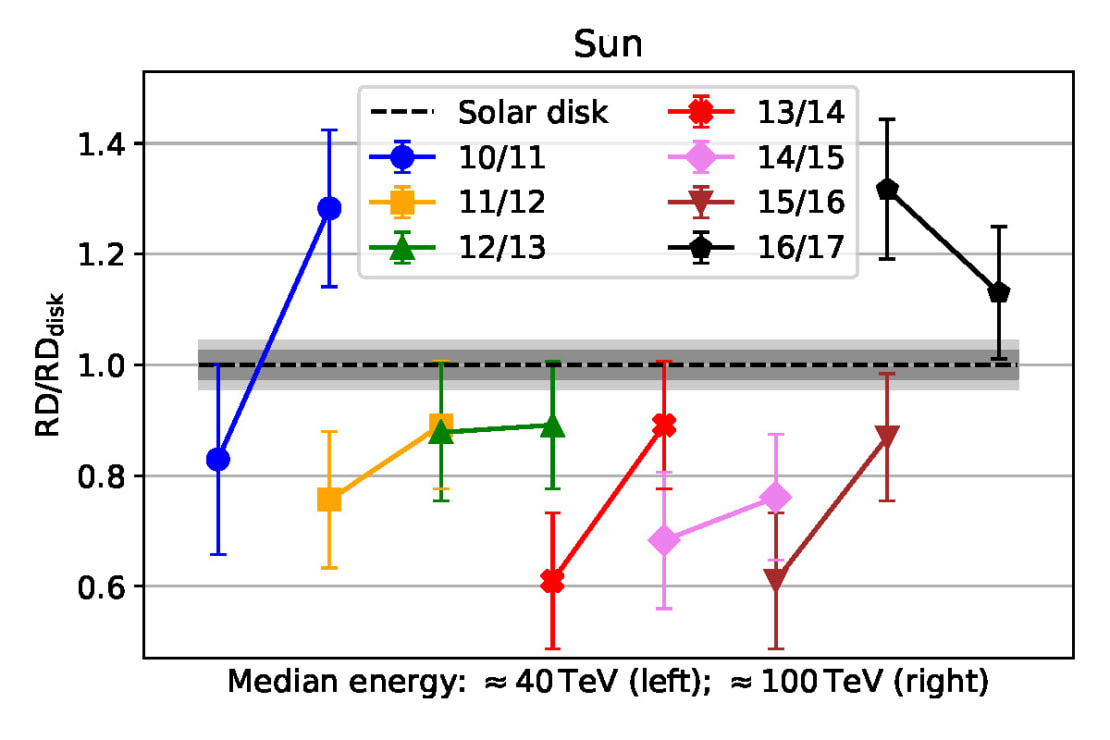Go outside on a sunny day and you will see an abundance of shadows. Trees, dogs, buildings, people—anything that obstructs sunlight casts a shadow. The sun also casts its own shadow, in a way—not by blocking light, but by blocking cosmic rays that would have reached Earth if the sun were not in the way, an effect aptly called the “cosmic-ray sun shadow.”
Cosmic rays are high-energy charged particles that reach Earth from all over the sky. When they travel close to the sun, some are blocked by the sun while others are deflected by the sun’s magnetic field, which thus affects the cosmic-ray sun shadow. As IceCube determined in an analysis published in 2019, we can learn about the solar magnetic field by studying its impact on the cosmic-ray sun shadow.
The IceCube Collaboration recently performed a succeeding analysis to try to expand our understanding of the solar magnetic field by studying the time-dependent cosmic-ray sun shadow, this time using seven years of data. They also wanted to explore how the cosmic-ray sun shadow changes at different energy regimes. The results, recently submitted to Physical Review D, show that more solar activity leads to a weaker sun shadow. There were also indications that, in times of high solar activity, the shadow becomes stronger at higher energies—a hint at sun-shadow energy dependence that will be explored more in future studies.

To study cosmic rays with IceCube, the researchers looked at IceCube data containing atmospheric muons: particles produced by cosmic rays interacting in Earth’s atmosphere. Frederik Tenholt, an IceCube collaborator at Ruhr-Universität Bochum in Germany, worked on this analysis for his PhD dissertation in the Plasma-Astroparticle Physics group led by professor Julia Tjus.
“In order to study the temporal variation of the cosmic-ray sun shadow and compare it to solar magnetic field models, we basically had to achieve two things,” says Tenholt.
First, Tenholt and his collaborators had to analyze seven years of IceCube data. Here, different data reduction steps had to be performed in order to reconstruct the cosmic-ray sun shadow for each of the seven years. Next, to understand the shadow, the team developed and implemented a simulation framework that simulates particle propagation in different solar magnetic field models as well as allows researchers to make predictions for the expected cosmic-ray sun shadow based on specific models.
Upon completing the analysis, Tenholt and his collaborators found that the data revealed a decreasing linear relationship between solar activity and sun shadow strength. “In other words,” says Tenholt, “more solar activity—i.e., a stronger magnetic field—leads to a shallower, or weaker, sun shadow.”

They also tested two models of the sun’s magnetic field to see which one best matched observations. It turned out that both models within statistical uncertainties still describe the observed shadows equally well.
Lastly, when they looked at the behavior of the shadow at different energies, they found indications that, in times of high solar activity, the shadow becomes deeper/stronger at higher energies, in agreement with theoretical predictions. To examine times of low solar activity, the researchers will need more data and an improved energy estimation.

“This is the first time that solar magnetic field models have been assessed using data from a huge neutrino detector like IceCube by directly comparing the measured cosmic-ray sun shadow to predictions on the data rate level,” says Tenholt. “This study sets a starting point for studying different phenomena related to solar physics—like the coronal magnetic field, coronal mass ejections, or the solar wind—by using data from IceCube.”
By using IceCube data, this study was able to probe the solar magnetic field within a few solar radii from the solar surface—a place for which there are no in-situ measurements. In the future, it might be possible to constrain the properties of the sun’s magnetic field using IceCube data. And by further improving the energy resolution for cosmic-ray–induced IceCube data, it will be possible to study the cosmic-ray sun shadow at different energies and thereby explore its energy dependence—something that Johan Wulff of Ruhr-Universität Bochum, another lead on this analysis, is planning to do soon.
“I am very excited to work on this analysis for my master’s thesis as it bridges the gap between theoretical solar magnetic field models and experimental IceCube data analysis,” says Wulff. “Such a broad issue allows me to develop skills on both, the experimental and theoretical side of physics. By working on an improved energy reconstruction, I hope to open the door for energy-dependent shadow studies and investigations of magnetic field effects at different energies.”
info “Measurements of the Time-Dependent Cosmic-Ray Sun Shadow with 7 Years of IceCube Data – Comparison with the Solar Cycle and Magnetic Field Models,” IceCube Collaboration: M. G. Aartsen et al., Physical Review D 103, 042005 (2021), journals.aps.org, arxiv.org/abs/2006.16298